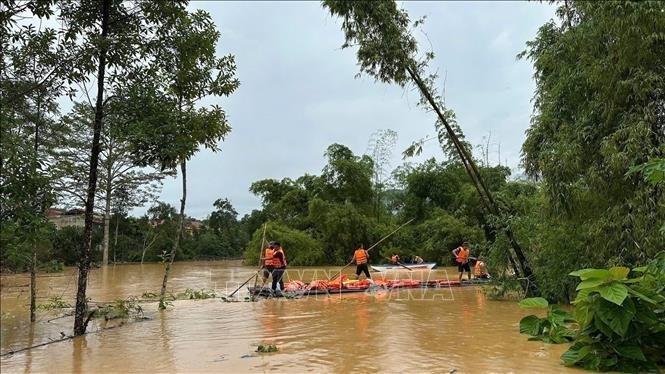Preliminary statistics from the Vietnam Disaster and Dyke Management Authority under the Ministry of Agriculture and Environment showed that 16,918 houses were flooded, 1,608 were isolated, and 710 suffered severe damage.
In the agricultural sector, 22,579 ha of rice and crops were inundated and damaged, while 1,038 head of cattle and 217,235 poultry were reported dead or washed away.
    |
 |
|
Rescue forces work urgently to evacuate 270 students trapped at Na Ri Ethnic Boarding School. |
A serious incident occurred at the Bac Khe 1 hydropower dam in Tan Tien commune, Lang Son province. The dam, with a capacity of around 4 million cu.m and a capacity of 2 MW, broke after a sudden surge in inflows. The incident was detected in time, enabling authorities to evacuate 803 households to safe areas before it happened.
In terms of transport, 66 locations along national highways were blocked by landslides and flooding. Traffic is expected to resume by the evening of October 8. The Hanoi – Dong Dang railway line also suspended operations. Many provincial and rural roads were heavily flooded and severely disrupted.
Thirteen people have been reported dead or missing, while seven others were injured. Localities are continuing to verify and update damage reports.
On October 8, four working delegations led by the Prime Minister and Deputy Prime Ministers inspected disaster response efforts in the provinces of Thai Nguyen, Bac Ninh, Cao Bang and Lang Son.
PM Pham Minh Chinh has issued Decision No.2221/QD-TTg to provide urgent aid worth 140 billion VND (around 5.6 million USD) from the 2025 central budget contingency fund to help four northern provinces recover from recent floods.
The National Civil Defense Steering Committee has also issued Dispatch No. 14/CD-BCD-BNNMT, urging proactive response to extremely high flood levels on the Cau and Thuong rivers.
To ensure the safety of the dyke system, the committee requested provincial and municipal People’s Committees to urgently mobilize all available forces, materials and equipment to reinforce vulnerable dyke sections and prevent overflows or breaches, ensuring safety when floodwaters continue to rise.
They were also instructed to regularly inspect key and weak dyke sections, unresolved incidents, and ongoing construction sites, particularly low dykes near rivers prone to seepage, erosion or subsidence during floods. Authorities must strengthen patrols and surveillance during the flood season to promptly detect and handle any incidents.
Local authorities have also been directed to urgently evacuate residents from low-lying and riverside areas at high risk of flooding to safe locations.
Source: VNA